
Simple Hacks to Naturally Boost Your Immune System
April 20, 2020
Zinc Supplement
April 28, 2020
Vitamin D, sometimes called the ‘sunshine vitamin’, is in fact a hormone that plays a major role in our overall health. It is one of the fat soluble vitamins which includes vitamin A, D, E and K. It differs from other vitamins in the fact that it is produced within the body. We can get small amounts of vitamin D from food sources, but the main source is a stepwise process that starts in your skin when exposed to ultraviolet (UV) light from the sun, and continues in our liver and kidneys where the final product is formed: active Vitamin D3.
For those who love to geek out on science (like I do), I’ll briefly explain the pathway of how vitamin D is made in our body. For those who don’t, you’re welcome to skip the next two paragraphs!
Vitamin D3 is produced in the skin via a two-step process. In the skin, 7-dehydrocholesterol (7-DHC) is broken down by the UV radiation of the sun – specifically UVB radiation – into pre-D3 which is then converted into D3 via a heat-sensitive process. None of these ‘reactions’ are caused by enzymes; they are all a result of the UVB radiation from the sun.
Now, the vitamin D3 gets converted into calcidiol or 25 hydroxyvitamin D3 (25OHD3), mainly in the liver but also elsewhere in the body. The next step occurs in the kidneys, but again, in other tissues too, where 25OHD3 is converted into the active form of vitamin D called calcitriol or 1,25 hydroxyvitamin D3 (1,25(OH)2D3). These reactions are carried out by a group of enzymes known as CYPs. This is the steroid hormone and metabolically active form of vitamin D as it is what binds the vitamin D receptor (VDR). When it binds the VDR, it can attach to our DNA, controlling hundreds of genes as a result, turning genes on and off, and this is why it has a huge impact on multiple biological processes in the body. If you think about it, this is epigenetics at work! – The change in an organism as a result of something causing a change in the way the genes are expressed, and not because of a change in the actual DNA sequence.
For those of you who skipped the details, briefly, the sun’s UV energy converts a chemical in your skin into Vitamin D3, which is taken to your liver and kidneys to be converted into the active form of vitamin D.
Before you jump into the article, sign up to receive your free guide below!
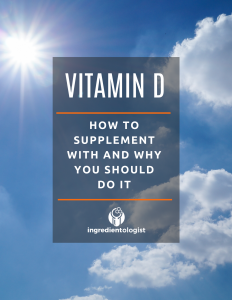 |
|
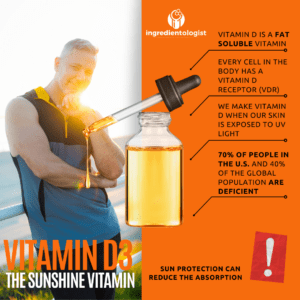
Vitamin D and our health
Recent research has shown that every cell in the body has a vitamin D receptor (VDR). That alone helps to explain why it is so fundamental to our health. As I explained above, when vitamin D binds to the VDR, a whole host of genes are affected which influence how our bodies function.
Currently, it is estimated that 70% of the people in the United States have a vitamin D deficiency while over 40% of the global population are deficient. This is probably due to lifestyle changes over time that have reduced our exposure to the sun and therefore affected our vitamin D levels directly. We work mostly from indoor offices, compared to working on farms in the past. We eat in restaurants or in our houses, we spend most of our time glued to screens indoors and we even exercise indoors!
We’re now seeing that even people living closer to the equator, where sun exposure is sufficient, are vitamin D deficient. Because vitamin D deficiency is associated with many diseases and mortalities, this has become a pandemic that a lot of research has gone into, with many drugs being produced that are structurally similar to vitamin D as well as foods like cereals and milk that are fortified with vitamin D.
Most commonly known is rickets, a disease caused by poor bone mineralization causing soft bones and is mostly seen in children in developing countries where vitamin D deficiency is common. Vitamin D deficiency is also associated with an increased risk of diabetes, high blood pressure, heart disease, various forms of cancer, autoimmune and inflammatory diseases, decreased immune defenses and increased mortality. Vitamin D plays an essential role in the regulation of blood glucose and insulin levels, which are important for healthy weight control, and attenuating inflammation that is caused by obesity.
With that said, it is obvious that this vitamin has important functions, but perhaps two of the most vital are the absorption of calcium and phosphorus which influence bone health, and the regulation of the immune system.
The former helps us to maintain healthy and strong bones. Low bone calcium stores, increases our risk for fractures and bone diseases – something you really don’t want as you age! Without vitamin D, we can only absorb 10-15% of dietary calcium, but this is improved by 30-40% when we have normal reserves. Additionally, lower calcium and phosphorus stores cause a rise in a hormone called parathyroid hormone (PTH) which acts to release calcium from our bones (to try and compensate for the lower calcium absorbed from the gut), leading to low bone mineral density.
There is a strong correlation between Vitamin D levels and immune function. It is no coincidence that the hype around supplementing with vitamin D has skyrocketed since the spread of the virus.
Vitamin D influences the proliferation and differentiation of immune cells. Without vitamin D, our immune cells aren’t able to fight off infections. Studies continue to show how low vitamin D levels are associated with upper respiratory tract infections (URTI), acute lung injury, tuberculosis and other respiratory diseases like asthma.
A recent study showed that vitamin D supplementation could reduce the risk of getting a respiratory tract infection by up to 50%, with a greater effect for those who were already deficient.
Calcitriol, a drug that is the metabolically active form of vitamin D, influences host immunity in two different important ways: it suppresses adaptive immunity, while it stimulates innate immunity, two processes that regulate our immune response to infection. It is understood that when vitamin D is converted to its active form, it turns on genes that make cells and proteins that are essential for a robust immune response.
Evidence that Vitamin D influences the immune system
There are a few points to highlight that support the fact that vitamin D is indeed one very important vitamin when it comes to our immune system’s strength.
- Seasonality of viruses:
The main source of vitamin D is the sun’s UV radiation, and because it varies in intensity throughout the seasons and at different geographic locations, we see that vitamin D deficiency is common during the winter months (Oct – Mar) in northern latitudes 20 degrees above and (Apr – Sep) in the southern hemisphere 20 degrees below the equator.

- A well-known study showed that children who were exposed to UV light had a 2x lower incidence of upper respiratory tract infections, the flu and sore throat compared to children who were non-exposed.
- We see a difference in influenza virus rates in rural vs urban areas, with rural people having lower infection rates and higher vitamin D levels – due to working and spending more time outside, compared to city dwellers who spend most of their time indoors.
- As mentioned above, there is a profound preventative effect of vitamin D supplementation bacterial and viral chest infections. A low vitamin D status is associated with a greater URTI incidence. This is because vitamin D increases immunity and decreases inflammatory responses, lowering the risk of infection.
These points tell us that it is very likely that a low vitamin D status can increase your risk of getting some sort of respiratory disease. As we will discuss, this is extremely important during the current period we are in with the virus pandemic.
Supplementing with vitamin D3
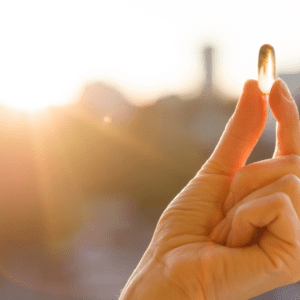
There are only 3 ways you can get vitamin D:
- Sun exposure
- Food Sources
- Supplements
Before supplementing with vitamin D3, you should make sure you’re getting sufficient sun exposure every day and eating enough food sources of D3. You should also consider getting your levels tested.
Know your levels
The best way is to test for ‘25 hydroxyvitamin D3 TOTAL’ or ‘25(OH)D3 TOTAL’ by getting a blood test from your doctor.
Preferred levels are between the range of 30 – 60ng/ml, but vitamin D deficiency is a problem all over the world and 42% of Americans are vitamin D deficient! Levels of 20ng/ml reflect vitamin D inadequacy, while 20-30ng/ml are borderline deficiency.
Vitamin D from the sun
Researchers found that one full-body exposure to UV radiation that causes slight pinkness in the skin – which they called the minimum erythemal dose, 1 MED – is equal to supplementing with 10,000 – 25,000IU of vitamin D. That’s a lot!
We definitely can get enough vitamin D produced in our bodies from the sunlight, but we need to be conscious about making this a routine part of our lives. More recent recommendations say that 15 minutes of sun exposure, or until the skin turns slightly pink, between 10am and 3pm can produce roughly 3000IU of vitamin D in the body. Another bonus is that vitamin D produced from the sun can last twice as long in the blood compared to vitamin D from the diet.
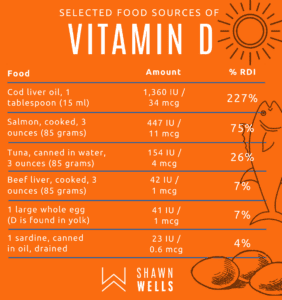
Vitamin D from food
Relying on foods as a source of vitamin D alone is not ideal as it is hard to reach the amount you need since very few foods contain significant levels.
Food sources include: cod liver, eggs, liver, fatty fish like salmon (which all contain D3), and mushrooms (mushrooms contain D2).
In some countries there are fortified foods like cereals and milk, however one glass of milk contains only 100IU. So coupling sun exposure with a good diet is key.
Cod liver is the single best source of vitamin D. Just 1 tablespoon (15ml) can give you more than you need per day. Fatty fish like salmon is also good, but you would need to be eating this everyday, which is unlikely.
Factors leading to lower Vitamin D levels
Several factors influence how much of the precursor chemical in our skin gets converted into the active form of vitamin D3. Below are some of the major ones to consider, and could help determine whether you should be supplementing or not.
- African American → Darker skin means a higher amount of melanin in the skin – a protein that protects us from the sun’s UV radiation. It is hypothesised that humans adapted as they migrated north to less sunny regions by getting whiter skin, so that more vitamin D could be produced in the skin. Having darker skin is protective against too much sun exposure near the equator (at least before urbanization).
- Obesity → Research shows that the more obese a person is, the lower their vitamin D levels will be.
- Elderly → As we age, rates of vitamin D deficiencies are higher.
- Sun protection → Concerns about skin cancer have prompted people to wear sunscreen and protective clothing in the sun, which limits sun exposure and vitamin D production significantly.
- Season & latitude → The angle of the sun in the winter prevents people in the northern hemisphere from producing enough vitamin D. In the countries north of 35°N, no vitamin D is produced during the winter months. Smog/pollution and cloud cover also significantly reduce UV radiation.
- Outdoor behavior → There is an ongoing trend towards less outdoor activities, either for work or preferred leisure activities, increasing our susceptibility to vitamin D deficiency.
Taking these factors into account, you may need to be increasing your levels of vitamin D through supplementation.
Supplementing with vitamin D
When looking for vitamin D supplements it is important to know that there are two forms of vitamin D:
Vitamin D2 (ergocalciferol) → Found in some plants and fungi (mushrooms). Humans do not make D2.
Vitamin D3 (cholecalciferol) → Found in oily fish, fish liver oil and egg yolks. This is the form found in humans.
D3 is more effective than D2 as it raises and maintains elevated blood levels of vitamin D for a longer time. A study showed that 50 days after a period of supplementing with vitamin D, people who had D2 form had their levels return to baseline, whereas those who had D3 had elevated levels.
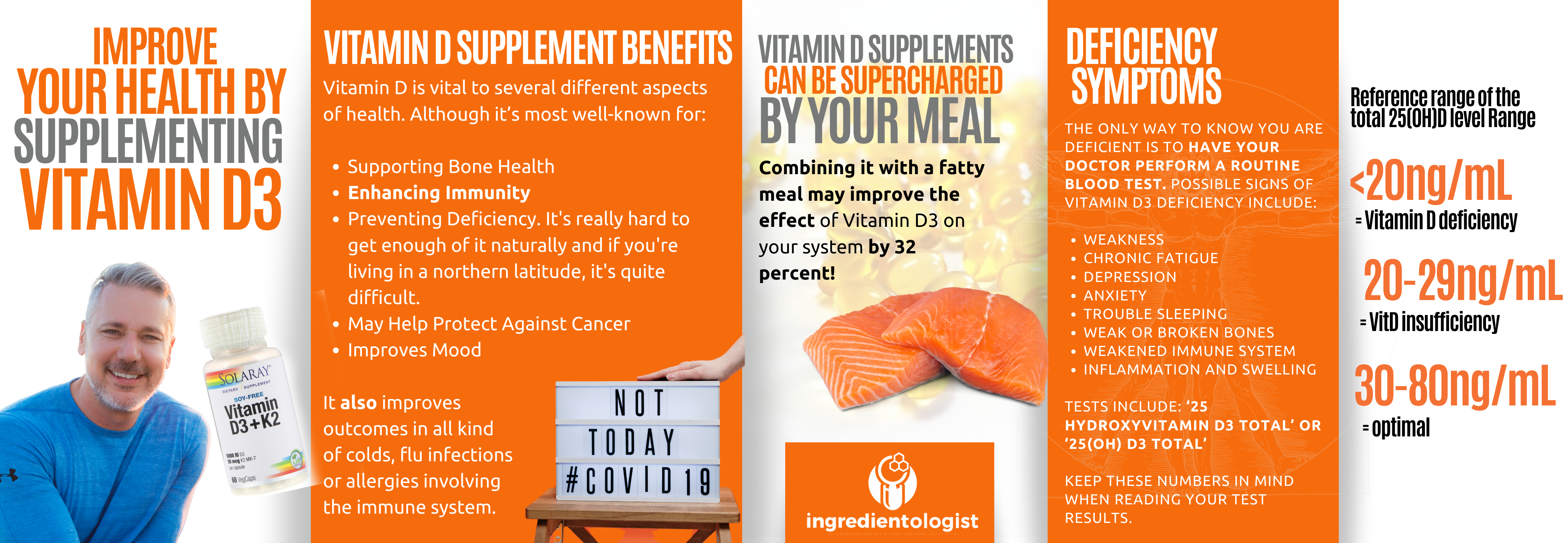
Vitamin D and Vitamin K work as a team
It’s not as simple as supplementing with vitamin D alone. Combining vitamin D with vitamin K2 is important because of how they work together in the body.
The role of vitamin D
To maintain adequate calcium levels in the bloodstream by two ways:
- Enhancing absorption of calcium from the food we eat in the gut.
- Releasing calcium from the body’s ‘calcium stores’ – our bones, when we don’t have enough calcium in our diet.
Calcium is essential for bone health, but also other vital functions in the body like muscle contraction and nervous system function.
The role of vitamin K
While vitamin D maintains calcium levels, it does not control where that calcium goes. Vitamin K does two things:
- Promotes calcification (the buildup of calcium) of bone – which means it ensures that the calcium goes to the right places like bones and teeth.
- Reduces calcification in soft tissues – this means that vitamin K prevents calcium from accumulating in tissues where a build up would be harmful, like our blood vessels and kidneys.
Together, vitamin D and K2 regulate calcium levels and its action in the body making sure that we have calcification in the right places.
There are two main types of vitamin K2: MK4 and MK7, with the latter being the biologically active form so I recommend looking for the MK7 version to stack with your vitamin D supplement. Vitamin K2 can also be found in leafy green vegetables, fermented legumes or vegetables as well as fatty animal-based foods like liver, egg yolk and cheese.
Vitamin D is a fat soluble vitamin, and so taking it with a source of fat can be helpful. It is also stored in our adipose tissue, and is released as needed if intake is too low. Supplements that have vitamin D in an oil based form have proven to be more bioavailable than those in a dry powder form, likely due to its fat soluble properties.
My top brands are:
- Now Foods
- Life Extension
- Sports Research (a Vitamin D3 form that is vegan, combined with coconut oil and vitamin K2 MK7)
Dose
The US Institute of Medicine recommends 400-800IU (or 10-20mcg) per day, but recommendations are continuously adjusted upward as some recommend 2000 IU/day or 60IU/kg. It really depends on your current levels, and the other lifestyle factors mentioned above. The upper limit is 4000IU per day, but taking vitamin D is generally very safe with little to no negative risks.
Current RDA’s are as follows:
- 400 IU → Infants (0-12 months)
- 600 IU → Children & Adults (1-70yrs) including breastfeeding and pregnant women
- 800 IU → Adults (70yrs and older)
(1mcg = 40IU)
The most obvious benefits from vitamin D supplementation is seen in people who have vitamin D deficiency (<20ng/ml) or insufficiency (20-29ng/ml). It was also found that higher doses taken monthly were less effective than taking a lower dose daily or weekly.
So, how do you get more vitamin D?
- Sensible sun exposure:
Getting at least 15 minutes of sunlight between 10am and 3pm can produce 3000IU naturally. Don’t wear sunscreen, sunglasses or other protective gear for the 15 minutes. - Supplement daily:
Consider a vitamin D supplement remembering to combine it with vitamin K2 (MK7 form) and a fat source.
Bottom line?
- Get at least 15 minutes of sunlight each day
- Don’t use sunscreen all the time
- Supplement with Vitamin D3 (and K2)
- Opt for daily or weekly doses instead of monthly

Vitamin D and Respiratory Tract Infections
I’d like to bring your attention to a study published in the British Journal of Medicine. It is a meta-analysis, which means the authors gathered many different studies on the topic and analyzed the data together to give an overall result, thus delivering high-quality evidence.
The study looked at the preventative effect of vitamin D supplementation on respiratory tract infections. The data showed that taking vitamin D as a supplement could reduce the risk of bacterial and viral chest infections.
Why is this important? Well, for two reasons:
- We know that respiratory diseases are a major cause of death globally and account for 10% of emergency department cases!
- Also for Infection associated with a respiratory condition, specifically ARDS (acute respiratory distress syndrome).
Briefly, how ARDS affects the lungs is by causing a major inflammatory response in the ‘air sacs’ of the lungs when a bacteria or virus infects us. This prevents the flow of oxygen and carbon dioxide between the blood and the air we breathe, and our immune system overreacts.
This study shows that vitamin D has the ability to control this overactive immune response, by downregulating the inflammatory response and increasing the number of immune cells that can fight infection, like lymphocytes, neutrophils, monocytes and dendritic cells.
It also showed that taking vitamin D daily or weekly gave a far more profound benefit compared to taking it in monthly doses, and that the benefits were greater in those who already had a low vitamin D baseline level.
It is now more important than ever to optimize our health. If you want to boost your immune system, take a look at my previous guides on medicinal mushrooms and vitamin C, and check out my instagram profile to share these graphics with your friends. Share this with your friends and family! We all need a reminder to get outside for some sunshine and nature. Share your time in the sun with me by tagging @ingredientologist!
References
Vitamin D Metabolism, Mechanism of Action, and Clinical Applications Daniel D. Bikle, VA Medical Center, Department of Medicine and Dermatology, University of California, San Francisco, San Francisco, CA 94121, USA http://dx.doi.org/10.1016/j.chembiol.2013.12.016
https://www.frontiersin.org/articles/10.3389/fendo.2019.00103/full
https://www.healthline.com/nutrition/how-much-vitamin-d-to-take#How-Much-Vitamin-D-Should-You-Take?
https://ods.od.nih.gov/factsheets/VitaminD-HealthProfessional/
https://www.ncbi.nlm.nih.gov/pubmed/29644951
Martineau AR, Jolliffe DA, Hooper RL, et al. Vitamin D supplementation to prevent acute respiratory tract infections: systematic review and meta-analysis of individual participant data. BMJ. 2017;356:i6583. Published 2017 Feb 15. doi:10.1136/bmj.i6583
https://www.ncbi.nlm.nih.gov/pmc/articles/PMC3356951/
https://www.healthline.com/nutrition/vitamin-d-101#deficiency
The Relationship between Ultraviolet Radiation Exposure and Vitamin D Status Ola Engelsen. Nutrients 2010, 2, 482-495; doi:10.3390/nu2050482
Hansdottir S, Monick MM, Hinde SL, Lovan N, Look DC, Hunninghake GW. Respiratory epithelial cells convert inactive vitamin D to its active form: potential effects on host defense. J Immunol. 2008;181(10):7090–7099. doi:10.4049/jimmunol.181.10.7090




